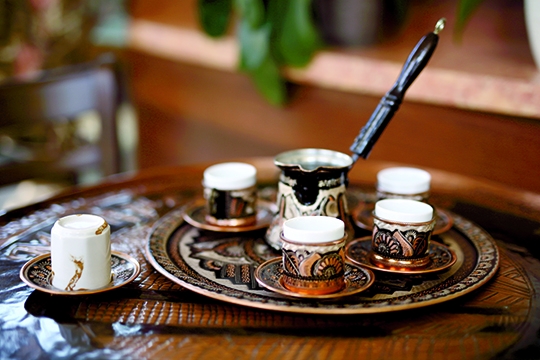The coffee was rich. The tale it told was richer.
I’d come to Mnimes Apo Tin Poli—one of a dying breed of Greek coffee shops—not for the grainy, sweet brew served in tiny cups. But for its whispers of my future.
On the outskirts of Athens, this oddly modern, heavily mirrored shop is one of a few where you can still get your fortune told by the sediment left behind in the cup, an art once practiced across Greece, Turkey and the Middle East.
I drank, overturned the cup and waited for the dregs to drip and dry. A no-nonsense young woman who learned the art from her grandmother took me to a private room. She stared into the cup for long, awkward moments.
There was a fox, a cunning person who would come into my life. And a fish, a sign of a good surprise, perhaps an inheritance (score!). After several years of turmoil, my love life would be stable (fingers crossed!). But most prominently?
“You will meet a nice woman who is tall and beautiful, and she will tell you something useful about your job.”
Hooey? Perhaps. But a day later, I stood in the kitchen of Argiro Barbarigou, Greece's leading voice on classic cooking. And her lesson on winter stews certainly changed the way I think about cold-weather comfort food.
They should taste and smell like a summer garden, Barbarigou said. A declaration seemingly at odds with the hearty dishes she was preparing, stirring hunks of potato and carrot into one, richly meaty beans into the other.
She intended to prove her point. Because in Greece, cold-weather dishes like these are less about heft and more about finding freshness, no matter the season. The result: meals that are substantial, yet feel and taste light and bright.
This unexpected turn might have been by design but was more likely a symptom of poverty, explained Barbarigou, who learned her recipes by cooking with women in rural villages.
“It was a very poor country, and maybe once a month we had meat. But we had a lot of herbs and wild greens,” she said. “This is the simplest food of the Greek cuisine. You smell the garden aromas. You smell the Greek summer.”
First off the stove, fasolada—a thick, rich stew of beans, carrots, onion and celery considered the national food of Greece. The flavors weren’t heavy. The beans were robust, yet tasted clean and simple. The carrot, celery and parsley distinct and layered. There was a brightness, too. As promised, it was unexpectedly summery.
After that, arakas—peas and potatoes studded with carrots. Again, where I expected weight, I got bright and herbal, the potatoes rich and fresh with a broth infused with dill. It begged for bread to sop up the juices. Crumbled feta cheese added punches of brine and cream.

It was unexpectedly welcome that dishes at a glance wintery could reflect such balance. But as she walked me through the recipes, it became clear there was a formula that kept the heartier ingredients in check.
Both recipes began with onion cooked in a generous glug of olive oil. Tomato paste was then cooked until thickened and fragrant, emboldening its acidity and sweetness. Both dishes also got sweetness from carrots—simmered in the arakas, sautéed in the fasolada.
Then the recipes diverged, yet followed a similar pattern. To their rich beginnings, starch was added: potatoes to arakas, beans to fasolada. At this stage, the dishes were heavy. Not unappealing, just classically winter fare.
Barbarigou pulled the arakas off the heat and quickly brought everything into balance, stirring in raw peas and generous fistfuls of fresh dill and mint. The gentle residual heat warmed the peas, yet left them tasting garden fresh. The herbs further lightened the dish, and a final splash of lemon juice brightened it.
This marriage of a hearty stew with bright flavors was repeated in the fasolada. Half of the carrots were added at the start. The rest only at the end, preserving their taste and texture. Acid again lightened the dish, this time with the relatively clean, simple flavor of red wine vinegar. Ample parsley offered freshness.
Both dishes got a final layer of flavor with a finish of crumbled feta. But there was still another lesson to learn. In both dishes, Barbarigou added some olive oil at the start and some at the end, whisking it into the liquid of the fasolada and drizzling it over the peas and potatoes of the arakas. The timing mattered, that last addition unifying the dish and adding a pleasant pepperiness.
The simplicity of these dishes made them easy to bring back to Milk Street. We found we liked the arakas slightly soupier, so we added more water. We also wanted more lemon, so we included the zest. And though Barbarigou had access to wonderful fresh peas, we found that frozen peas worked nearly as well.
Our changes to fasolada were equally simple. The flavor of low-sodium chicken broth added welcome savoriness to the stew, as did a bit of garlic with the onion. We also used a bit more tomato paste for richness. Finally, we found the finished soup had a more satisfying body if we mashed 1 cup of the cooked beans, then stirred them back in.
The result—a wedding of winter stews with summer flavors. Though I’m still waiting on my inheritance.





